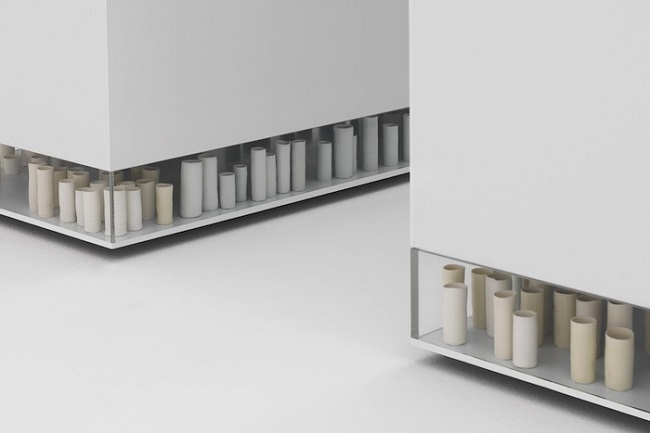Not all critics have a reverse gear. For most, it’s ever-forward. It’s wise for them to keep darting ahead as they are moving targets. But they too rarely reengage an opinion too strongly stated, a judgment that should be reversed on appeal and the inevitable criticism one writes when a dark mood pollutes his or her fragile objectivity.
No, I am not about to say that I really did love Edmund de Waal’s Gagosian show last year. I did not, as I made clear in my review. My problem remains with his boxes. His pottery hutches by themselves give neither purpose nor sculptural resonance to the compositions. And purely as compositions, while they have abstract beauty, they come at the end of a long line for this genre without much, if any, reinvention. This might be why Robert Smith in the New York Times described the wall pieces as “naive.”
However, a little like Professor Higgins (“By George, you’ve got it!” ), I must give credit where it is due. When I stumbled on a thousand hours I was transfixed, visiting it (virtually) a half dozen times. It works as art.
The fact is that the pottery by itself (and I admire De Waal for retaining the potter label) is not enough to create an art experience, at least not in the way he currently uses it, anonymous and de facto. It is the box that is the decider. It alone shifts the stature of the work from mere assembly to sculpture and until now it has never done that for me.
The the two slender vitrines resemble an architectural model for a 21st century minimalist tower. It has moved off the wall which takes away the constant china cabinet reference and allows the entire work (and the usually tethered pots) to breathe spatial oxygen. The proportions are elegant and the vitrine, although I think that term in insufficient in this case, thrusts upward. The pots on the bottom tier can be seen but not examined (unless one plans on lying on one’s stomach) and that by itself communicates that they are there as “ceramic art” but only as avatars for cultural expression.
The separate floors with glass create a kind of strata as Jon Sanders explains in Apollo Magazine:
“…a thousand hours asks you to explore its shape and the space it occupies: some of the porcelain vessels are positioned too high or too low to see without craning and crouching.
Its transparent glass case reveals vessels that are buried at several levels, like a cross-section of an archaeological dig. We can access only some of the porcelain, but all of it is potentially to be found. The piece reconstructs the buried histories of some of these items, such as the 16th-century fragments displayed in one of the collection cases, which were found by De Waal in the hills outside Jingdezhen. It addresses the fact that the history of porcelain is the history of its discovery.”
A thousand hours was the centerpiece of a major exhibition at the Alan Cristea Gallery in London. It is currently on view as one part of De Waals exhibition, a large scale intervention that moves through four re-curated galleries of Chinese porcelain. On White: Porcelain Stories from the Fitzwilliam is currently on display at the Fitzwilliam Museum (Cambridge, England from November 29, 2013 to February 23, 2014). The second part of the show, Yourself, was specially commissioned for the museums’s Chinese Gallery. De Waal has selected porcelain items from the permanent collections and placed them alongside objects from his residency in China, including poetry, photographs and letters. The exhibition examines the history of white and what it is that fascinates De Waal about porcelain.
There is a lot of personal charm in this exercise, one that antiquities departments are exploring more frequently these days to brush the dust off their holdings and create a bridge to the present. The late Gwyn Hanssen Pigott did a great job of that at the Sackler-Freer Galleries in Washington D.C. CFile will soon visit another project, Eric Zetterquist’s macro photographs, that are part of the renovated Chinese porcelain gallery of the Philadelphia Museum of Art.
However, Yourself is not the purpose of this commentary. You are welcome to visit this part of the exhibition via the links below and read brochure that accompanies it.
The purpose is to give deserved praise to a thousand hours and grease my reverse gear lest it become rusty.
Garth Clark is the Chief Editor of Cfile.
Above: Edmund De Waal’s a thousand hours on show at the Fitzwilliam Museum’s exhibition On White: Porcelain Stories from the Fitzwilliam. Photograph courtesy of the artist and the Fitzwilliam Museum, Cambridge.
Any thoughts? Love? Hate? Further information? Errors? Please do add your comments to the discussion of this post below.


Edmund De Waal’s a thousand hours on show at the Fitzwilliam Museum’s exhibition On White: Porcelain Stories from the Fitzwilliam. Photographs courtesy of the artist and the Fitzwilliam Museum, Cambridge.
Edmund de Waal talks about the ceramics of the Fitzwilliam and the ideas they inspire.
Read the brochure for yourself

Hauntingly beautiful on so many levels, for me this Edmund De Waal most powerful work to date.
Thanks, Julie!